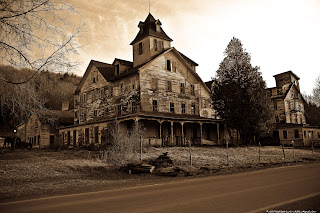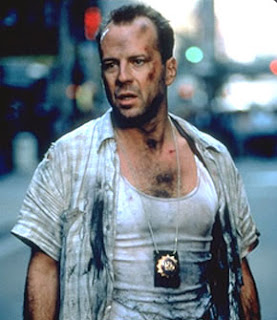The Parlour scene begins by
an invitation from Norman to Marion to use the parlour as a place to eat
instead of her room or the office. As the two characters step inside the room
Norman proceeds to switch the lamp on and she follows but stops at the door. Hitchcock starts with a mid-shot of Marion to
show her initial reaction but then switches to a close-up of an owl with its’
wings spread wide and appearing to look towards her like it would its prey. The
shot then goes back to the mid-shot of Marion but this time her reaction is a
little startled and she seems to think it is odd. There is also use of
non-diegetic sounds here with the background music that is neither calm nor very
tense but rather on edge and this is how Hitchcock sets the scene.
Inside the parlour we
discover the room is very small and the present furniture barely fits in it. The
composition of this shot, another mid-shot but also a two shot this time, shows
this but also how scarce the furniture is; two chairs, a side table, coffee
table and a box/trunk (excluding the ridiculous volume of stuffed birds there
are scattered around). Noticeably on the side table, where Norman puts the food
down when he first enters, is a single lamp that is not only the only light source
for the room but the scene as well.
The light is used to show the
different sides of the characters personalities. The continuous use of
mid-shots when presenting either character demonstrates that Norman is farther
away from the lamp than Marion which casts a shadow over half of his face. This could perhaps represent a divide between Norman’s
split personality of courteousness and anger, which is shown later on. The low
lit surroundings also help emphasise and showcase powerful shadows of Norman’s
head and shoulders and other objects sat behind him onto the walls that may
symbolise his dark side and correspondingly add tension to the scene.
Marion however is positioned
just to the rear-left of the lamp rendering her face to be well lit and
seemingly radiating lustrous warmth. This is feasibly ironic due to the fact
that she had stolen a mere forty thousand dollars from her manager, she is not
half-cast by the shadows; suggesting some kind of consumed evil or dark side, but
conversely in the bright light signifying that although in the wrong, Marion
may still correct her wrong-doings. Observe in addition how the setting behind
her contains no angular shadows but instead a rounded frame.
The use of camera angles throughout
the scene is interesting as Hitchcock uses different techniques in order to
create tension and contrasting serenity. His first choice is what seems to be
straight on mid-shots yet when the camera switches to Norman it always appears
to be pointed slightly upwards possibly implying he has more power over the
situation than first thought. This aside, a state of balance is created between
the two characters; Marion comfortably sits in her chair and Norman talks to
her while she eats. The angle is also from a point-of-view letting the audience
see the different perspectives and get a feel for each character.
The camera angle then
progresses for Norman to the left of him when the conversation of his Mother
arises displaying two clear-cut square frames and accordingly two birds looming
behind him; one of the owl seen earlier and another of an eagle in predator
mode. The camera looks up at Norman to
accentuate the birds, which are a continuing theme throughout, and create
tension in the scene as the audience are left to feel vulnerable as they look
up to him. A shadow of a bird is also encompassed into the shot to perhaps
foreshadow death that is soon to come.
The choice of theatrical
property that Hitchcock chooses to include in each frame helps to define how
each character is presented likewise. Straight lines, such as the photo frames,
surround Norman and are nearly always rested at an angle, due to the camera positioning,
suggest that his state of mind is uneasy and unbalanced thus creating a
correspondingly uneasy atmosphere. Norman’s clothing is vastly dark matching
one side of his persona and striking black shadows onto the wall.
Hitchcock however dresses Marion
in a light grey dress that wraps around her tightly suggest security, at this
point. Throughout the scene she takes
small bites out of her piece of toast that Norman has provided her and as
tension builds up she eats less adding to the effect. Laid out in front of her
is a tray with the rest of the meal and weirdly a jug of milk instead of a
glass. The jug is smoothly curved showing Marion as a graceful individual
rather than the sharp lines used to characterise Norman. The lamp on the table
beside her mimics these lines and glows peacefully enhancing the impression of
her.


